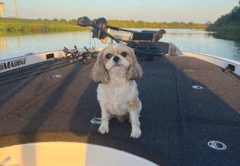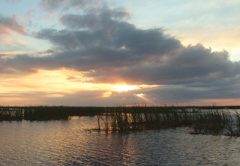2016 GULF RECREATIONAL RED SNAPPER STATE SEASON SET
APRIL 13, 2016 | BY: FWC AMANDA NALLEY
At its April 13th meeting in Jupiter, the Florida Fish and Wildlife Conservation Commission (FWC) set the 2016 recreational red snapper season in Gulf of Mexico state waters. The 2016 season will open Saturdays and Sundays in May starting May 7. On May 28, the season will open continuously through July 10. Finally, the season will reopen for Fridays, Saturdays and Sundays in September and October, and on Labor Day. This would provide for a 78-day season in Gulf state waters.
This Season will help maintain fishing opportunities for recreational anglers in state waters and provide additional May and fall weekend fishing days. The private recreational angler red snapper season in Gulf federal waters has not yet been announced by NOAA Fisheries but is estimated to be 6 to 9 days. The federally- permitted charter boat and headboat season for federal waters is estimated to be 38 to 56 days. Both of these federal seasons are slated to open June 1.
Learn more about red snapper at www.MyFWC.com/Fishing by clicking on “Saltwater”, “Recreational Regulations”, and “Snappers”.
ANDE LINE BRAID SERIES
BY: CAM PALM BEACH
Chuck Gerlach, President of Ande, began the long process of developing a line of Ande Braid in the summer of 2014. It took over a year to just get some samples. He didn’t have the final product that was good enough to be called Ande, until the end of last year. Braided line, unlike the traditional monofilament takes a very long time to produce. There are companies with thousands of braiders that work six and a half days to produce one spool. The spools are formed with 4, 8, 12 or 16 strands. Ande uses 8 and it takes a machine 24 hours to produce 50 meters of braid. Unlike much of the competition, Ande is priced the same for the full range of sizes, from 20lb to 150lb test in spool sizes ranging from 325 to 3250 yards so when you start getting into the higher ranges it has a much lower cost.
Chuck wasn’t thrilled about getting into the braid business, he is a nylon monofilament guy that believes in the “sport” of a fishing line that is true to its stated test to challenge the angler. But everyone seemed to be fascinated with braided line, and anglers were looking for a better braid product. It has great applications but it’s not the ‘everything’ product for all situations. For example, deep droppers love it because there is less weight to get your bait down. Anglers fishing for bass love it; they can pull a monster out of heavy cover, no question!
We talked with some Ande pros to get their take on the newest “Line of Champions”. Captain Rick Croson of Living Waters Guide Service in Wilmington, NC says, “It’s the real deal! It is smooth with a small diameter that makes no noise going through the eye of the rod.” He spends 70% of his time popping and jigging. The other 30% of his time is spent offshore trolling. He is able to put a huge amount of line on smaller tackle so clients fishing for marlin don’t have to fight with a big rod and reel. His biggest offshore rig is a Shimano Talica 20.
Captain Don Dingman in Jacksonville FL of “Hook the Future” loves that the line has no wind knots, and when you are fishing with a bunch of kids that can be a real nightmare. He can cast 30-40 foot farther with Ande Braid when fishing for cobia. The sensitivity of the line is so great that you can feel the swordfish bite fishing at 2000 feet. Captain Don says, “It has all the positives without the negatives.” Bottom line: it is light, colorfast, doesn’t make noise, no wind knots, and be careful not to put your fingertips on the line to apply pressure!
BOCA GRANDE PASS GEAR RESTRICTION BOUNDARY SHIFTS
MARCH 18, 2016 | BY: FWC AMANDA NALLEY
Sands shift and when they do, sometimes, buoys must be moved and boundaries changed. That’s what happened recently in Boca Grande Pass. Recent changes to the buoys marking Boca Grande Pass will affect tarpon anglers and others fishing in the Pass during the months of April, May, and June.
Earlier this year, several buoys marking Boca Grande Pass were moved by the U.S. Coast Guard to better align with the shifting channel. One buoy specifically, Flashing Red Buoy #12, was a reference point marking the boundaries of Boca Grande Pass for the purposes of specific gear restrictions. Red buoy #12 was removed and replaced with a new buoy, Charlotte Harbor Channel LB 6. This new buoy is about a quarter mile east-southeast of the old buoy.
Regulations that apply within this area defined as Boca Grande Pass include:
- Fishing with gear that has a weight attached to a hook, artificial fly or lure in such a way that the weight hangs lower than the hook when the line or leader is suspended vertically from the rod is prohibited year-round
- No more than three fishing lines may be deployed from a vessel at any one time during the months of April, May and June.
- No person shall use, fish with or place in the water any breakaway gear during the months of April, May and June. To learn more about tarpon, visit www.MyFWC.com/Fishing and click on “Saltwater”, “Recreational Regulations”, and “Tarpon”.
IMMOKALEE PANTHER RELOCATED
APRIL 13, 2016 | BY FWC: CARLI SEGELSON
On April 12th, the Florida Fish and Wildlife Conservation Commission (FWC) and the U.S. Fish and Wildlife Service (USFWS) captured a Florida Panther that had been frequenting a neighborhood near Immokalee in Collier County.
Residents in Farm Worker’s Village reported frequent sightings of panthers in close proximity to their homes and that serval pets had gone missing. Panther biologists visited the site and confirmed panther activity in the area. They also found evidence that small animals in the neighborhood including pets had been preyed upon by a panther.
Biologists monitored the situation by installing trail cameras and confirmed the presence of at least two panthers. The FWC and USFWS staff made numerous site visits and held multiple meetings at the Village to provide information about the steps residents can take to reduce risk and to deter the panther from lingering in the area. The FWC and USFWS are working with the property manager to address overgrown vegetation in and around the neighborhood.
On Tuesday, April 12th, biologists set traps and successfully captured a young male panther they were targeting. This panther was the one documented most frequently on the trail cameras. The panther will be initially held for a health exam. Once it is confirmed the panther is healthy. The plan is to return it to the wild in a more remote location.
Trapping of panthers that present a public safety risk is consistent with the Interagency Panther Response Plan.
For more information about coexisting with panther, visit www. FloridaPantherNet.org and click on “Living in Panther Country” in the top left corner.
BREVARD COUNTY FISH KILL SPARKED BY ‘BROWN TIDE’ REACHING TO SEBASTIAN
MARCH 30, 2016 | BY: TYLER TREADWAY OF TCPALM
The recent fish kill in the Banana River might be the beginning of the end for the northern Indian River Lagoon. Fish have stopped dying, and it’s unlikely the carnage will spread south toward the Treasure Coast. But irreparable damage may have been done.
The Florida Fish and Wildlife Conservation Commission reports “at least tens of thousands” of fish died from March 18 to 20 in the Banana River, an arm of the Indian River Lagoon that stretches from Kennedy Space Center to just north of Melbourne in Brevard County, said spokeswoman Kelly Richmond. “But it could be more.”
A lot more, according to Zack Jud, a marine biologist and education director at the Florida Oceanographic Society in Stuart. “I’d estimate there are tens of millions of dead fish,” Jud said. “I’ve seen dead fish piled up from shore to shore in a single photo that represented tens of thousands of fish.”
Reports show 16 species of fish and crabs died in the incident: red drum, black drum, puffer, sting ray, hardhead catfish, mullet, flounder, blenny, sheepshead, spotted sea trout, blue and horseshoe crab, snook, anchovy, mojarra and sea robin, Richmond said. Jud estimated up to 50 species of fish and other marine animals died in the incident. “It’s so huge and so widespread, it could absolutely crush the Banana River ecosystem,” Jud said. “The northern end of the lagoon has been at a tipping point for a while now. This might be enough to push it over the edge.
Both Jud and the FWC tie the fish kill to high levels of an algae known as “brown tide,” Aureoumbra lagunensis, that has been reported in the Banana River since November and has been blooming since January. Brown tide has been reported in the lagoon as far south as Sebastian. A fish kill there like the one in the Banana River is possible, Jud said, but not likely. “The brown tide concentrations just aren’t high enough,” he said. “At least not now.”
The incident is not related to the Lake Okeechobee discharges into the St. Lucie River and lagoon at Stuart. Discharge water doesn’t go that far north. The bloom in the Banana River kept growing until it suddenly died in mid-March, according to Kilroy remote- controlled water monitors in the Banana River installed by the Fort Pierce-based Ocean Research & Conservation Association. “It could be that the bloom killed itself off, consumed all the nutrients in the water and just crashed,” Jud said. All that dead algae fed an explosion of bacteria, which in turn sucked all the oxygen out of the water. Kilroys show oxygen levels in the Sykes Creek area of the Banana River “bottomed out” at 3 a.m. March 19, said Edie Widder, ORCA’s founder and lead scientist. With no oxygen, fish suffocated. Oxygen levels are now back to normal at most sites in the Banana River, and Richmond said reports of dead fish have stopped.
The water is much clearer because all the algae is gone, Jud said, but there were reports Monday of more fish seen gasping for oxygen in the Banana River. Now the concern is that all the dead fish carcasses will trigger another round of algae and bacteria.







